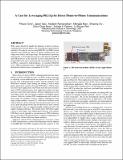| dc.contributor.author | Choi, Pilsoon | |
| dc.contributor.author | Gao, Jason Hao | |
| dc.contributor.author | Ramanathan, Nadesh | |
| dc.contributor.author | Mao, Mengda | |
| dc.contributor.author | Xu, Shipeng | |
| dc.contributor.author | Boon, Chirn-Chye | |
| dc.contributor.author | Fahmy, Suhaib A. | |
| dc.contributor.author | Peh, Li-Shiuan | |
| dc.date.accessioned | 2014-09-18T15:05:24Z | |
| dc.date.available | 2014-09-18T15:05:24Z | |
| dc.date.issued | 2014-08 | |
| dc.identifier.isbn | 978-1-4503-2975-0 | |
| dc.identifier.uri | http://hdl.handle.net/1721.1/89796 | |
| dc.description.abstract | WiFi cannot effectively handle the demands of device-to-device communication between phones, due to insufficient range and poor reliability. We make the case for using IEEE 802.11p DSRC instead, which has been adopted for vehicle-to-vehicle communications, providing lower latency and longer range. We demonstrate a prototype motivated by a novel fabrication process that deposits both III-V and CMOS devices on the same die. In our system prototype, the designed RF front-end is interfaced with a baseband processor on an FPGA, connected to Android phones. It consumes 0.02uJ/bit across 100m assuming free space. Application-level power control dramatically reduces power consumption by 47-56%. | en_US |
| dc.description.sponsorship | Singapore-MIT Alliance for Research and Technology | en_US |
| dc.description.sponsorship | American Society for Engineering Education. National Defense Science and Engineering Graduate Fellowship | en_US |
| dc.language.iso | en_US | |
| dc.publisher | Association for Computing Machinery (ACM) | en_US |
| dc.relation.isversionof | http://dx.doi.org/10.1145/2627369.2627644 | en_US |
| dc.rights | Creative Commons Attribution-Noncommercial-Share Alike | en_US |
| dc.rights.uri | http://creativecommons.org/licenses/by-nc-sa/4.0/ | en_US |
| dc.source | MIT web domain | en_US |
| dc.title | A Case for Leveraging 802.11p for Direct Phone-to-Phone Communications | en_US |
| dc.type | Article | en_US |
| dc.identifier.citation | Pilsoon Choi, Jason Gao, Nadesh Ramanathan, Mengda Mao, Shipeng Xu, Chirn-Chye Boon, Suhaib A. Fahmy, and Li-Shiuan Peh. 2014. A case for leveraging 802.11p for direct phone-to-phone communications. In Proceedings of the 2014 international symposium on Low power electronics and design (ISLPED '14). ACM, New York, NY, USA, 207-212. | en_US |
| dc.contributor.department | Massachusetts Institute of Technology. Computer Science and Artificial Intelligence Laboratory | en_US |
| dc.contributor.department | Massachusetts Institute of Technology. Department of Electrical Engineering and Computer Science | en_US |
| dc.contributor.mitauthor | Choi, Pilsoon | en_US |
| dc.contributor.mitauthor | Gao, Jason Hao | en_US |
| dc.contributor.mitauthor | Peh, Li-Shiuan | en_US |
| dc.relation.journal | Proceedings of the 2014 International Symposium on Low Power Electronics and Design (ISLPED '14) | en_US |
| dc.eprint.version | Author's final manuscript | en_US |
| dc.type.uri | http://purl.org/eprint/type/ConferencePaper | en_US |
| eprint.status | http://purl.org/eprint/status/NonPeerReviewed | en_US |
| dspace.orderedauthors | Choi, Pilsoon; Gao, Jason Hao; Ramanathan, Nadesh; Mao, Mengda; Xu, Shipeng; Boon, Chirn-Chye; Fahmy, Suhaib A.; Peh, Li-Shiuan | en_US |
| dc.identifier.orcid | https://orcid.org/0000-0001-9010-6519 | |
| dc.identifier.orcid | https://orcid.org/0000-0003-0856-9026 | |
| mit.license | OPEN_ACCESS_POLICY | en_US |
| mit.metadata.status | Complete | |
